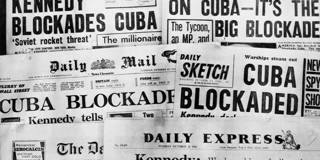A new book shows that the nuclear standoff in 1962 happened because, “operating under mutual distrust,” the Americans and Soviets “simply misread each other.” While Vladimir Putin and Joe Biden claim to seek a “stable and predictable” relationship, the risk of a devastating miscalculation is no less salient today.
MOSCOW – As US President Joe Biden prepares to meet with his Russian counterpart, Vladimir Putin, the stakes might not seem all that high. With bilateral relations at a post-Cold War low, and the United States more concerned about China than Russia, it is hard to imagine the relationship deteriorating further. And yet, as the historian Serhii Plokhy of Harvard University reminds us in his new book, Nuclear Folly: A New History of the Cuban Missile Crisis, the wrong move can all too easily take these old adversaries to the precipice of catastrophe.
In fact, conveying this message was Plokhy’s primary purpose in writing the book. As he explains in the introduction, we are living in a “second nuclear age,” characterized by the same kind of “nuclear brinkmanship” that marked the 1950s and early 1960s. The difference is that we are taking this threat far less seriously than we did in 1962. As Plokhy notes, “today there are world leaders prepared to take a more cavalier attitude toward nuclear weapons and nuclear war” compared to US President John F. Kennedy and Soviet leader Nikita Khrushchev.
To jolt us from our indifference, Plokhy does not just retell the story of the Cuban missile crisis; he rewrites it. According to the prevailing historical narrative, the world averted nuclear war thanks to the careful calculations of a brilliant US president, who, with the help of his closest advisers, “managed to make the right assumptions and draw the right conclusions about Soviet intentions and capabilities.” But, as Plokhy explains, the reality was very different.

MOSCOW – As US President Joe Biden prepares to meet with his Russian counterpart, Vladimir Putin, the stakes might not seem all that high. With bilateral relations at a post-Cold War low, and the United States more concerned about China than Russia, it is hard to imagine the relationship deteriorating further. And yet, as the historian Serhii Plokhy of Harvard University reminds us in his new book, Nuclear Folly: A New History of the Cuban Missile Crisis, the wrong move can all too easily take these old adversaries to the precipice of catastrophe.
In fact, conveying this message was Plokhy’s primary purpose in writing the book. As he explains in the introduction, we are living in a “second nuclear age,” characterized by the same kind of “nuclear brinkmanship” that marked the 1950s and early 1960s. The difference is that we are taking this threat far less seriously than we did in 1962. As Plokhy notes, “today there are world leaders prepared to take a more cavalier attitude toward nuclear weapons and nuclear war” compared to US President John F. Kennedy and Soviet leader Nikita Khrushchev.
To jolt us from our indifference, Plokhy does not just retell the story of the Cuban missile crisis; he rewrites it. According to the prevailing historical narrative, the world averted nuclear war thanks to the careful calculations of a brilliant US president, who, with the help of his closest advisers, “managed to make the right assumptions and draw the right conclusions about Soviet intentions and capabilities.” But, as Plokhy explains, the reality was very different.